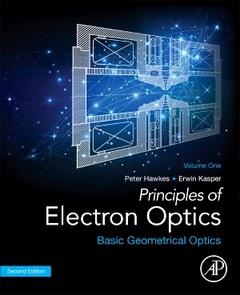Description
Principles of Electron Optics, Volume 1 (2nd Ed.)
Basic Geometrical Optics
Authors: Hawkes Peter W., Kasper Erwin
Language: English
Subjects for Principles of Electron Optics, Volume 1:
236.94 €
In Print (Delivery period: 14 days).
Add to cartSupport: Print on demand
Description
/li>Contents
/li>Readership
/li>Biography
/li>Comment
/li>
Volume one of Principles of Electron Optics: Basic Geometrical Optics, Second Edition, explores the geometrical optics needed to analyze an extremely wide range of instruments: cathode-ray tubes; the family of electron microscopes, including the fixed-beam and scanning transmission instruments, the scanning electron microscope and the emission microscope; electron spectrometers and mass spectrograph; image converters; electron interferometers and diffraction devices; electron welding machines; and electron-beam lithography devices.
The book provides a self-contained, detailed, modern account of electron optics for anyone involved with particle beams of modest current density in the energy range up to a few mega-electronvolts. You will find all the basic equations with their derivations, recent ideas concerning aberration studies, extensive discussion of the numerical methods needed to calculate the properties of specific systems and guidance to the literature of all the topics covered. A continuation of these topics can be found in volume two, Principles of Electron Optics: Applied Geometrical Optics.
The book is intended for postgraduate students and teachers in physics and electron optics, as well as researchers and scientists in academia and industry working in the field of electron optics, electron and ion microscopy and nanolithography.
1. Introduction
PART I – CLASSICAL MECHANICS 2. Relativistic Kinematics 3. Different Forms of Trajectory Equations 4. Variational Principles 5. Hamiltonian Optics
PART II – CALCULATION OF STATIC FIELDS 6. Basic Concepts and Equations 7. Series Expansions 8. Boundary-Value Problems 9. Integral Equations 10. The Boundary-Element Method 11. The Finite-Difference Method (FDM) 12. The Finite-Element Method (FEM) 13. Field-Interpolation Techniques
PART III – THE PARAXIAL APPROXIMATION 14. Introduction 15. Systems with an Axis of Rotational Symmetry 16. Gaussian Optics of Rotationally Symmetric Systems: Asymptotic Image Formation 17. Gaussian Optics of Rotationally Symmetric Systems: Real Cardinal Elements 18. Electron Mirrors 19. Quadrupole Lenses 20. Cylindrical Lenses
PART IV – ABERRATIONS 21. Introduction 22. Perturbation Theory: General Formalism 23. The Relation Between Permitted Types of Aberration and System Symmetry 24. The Geometrical Aberrations of Round Lenses 25. Asymptotic Aberration Coefficients 26. Chromatic Aberrations 27. Aberration Matrices and the Aberrations of Lens Combinations 28. The Aberrations of Mirrors and Cathode Lenses 29. The Aberrations of Quadrupole Lenses and Octopoles 30. The Aberrations of Cylindrical Lenses 31. Parasitic Aberrations
PART V – DEFLECTION SYSTEMS 32. Paraxial Properties of Deflection Systems 33. The Aberrations of Deflection Systems
PART VI – COMPUTER-AIDED ELECTRON OPTICS 34. Numerical Calculation of Trajectories, Paraxial Properties and Aberrations
Postgraduate students and teachers in physics and electron optics; researchers and scientists in academia and industry working in the field of electron optics, electron and ion microscopy, and nanolithography
Erwin Kasper studied physics at the Universities of Münster and Tübingen (Germany), where he obtained his PhD in 1965 and the habilitation to teach physics in 1969. After scientific spells in the University of Tucson, Arizona (1966) and in Munich (1970), he resumed his research and teaching in the Institute of Applied Physics, University of Tübingen, where he was later appointed professor. He lectured on general physics and especially on electron optics. The subject of his research was theoretical electron optics and related numerical methods on which he published numerous papers. After his retirement in 1997, he published a book on numerical field calculation (2001).
- Offers a fully revised and expanded new edition based on the latest research developments in electron optics
- Written by the top experts in the field
- Covers every significant advance in electron optics since the subject originated
- Contains exceptionally complete and carefully selected references and notes
- Serves both as a reference and text
These books may interest you

Geometrical Charged-Particle Optics 189.89 €

Geometrical Charged-Particle Optics 189.89 €


